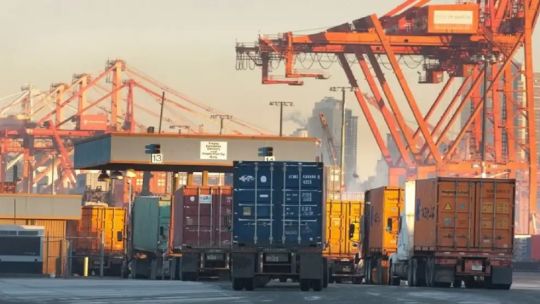
In a context of dollar shortage, the permanent reduction of farm export duties announced by President Javier Milei priorities the flow of hard currency in the foreign exchange markets over the fiscal accounts. The measure aims at stimulating liquidations to avoid exchange rate tensions ahead of the midterms, resigning tax revenue collection. Although the sector has already cashed in most of the harvest, US$10 billion still remain which could help to control possible leaps of the greenback.
Official and private estimates calculate that the fiscal cost of trimming farm export duties will be 0.2 percent of Gross Domestic Product (GDP) this year with the state relinquishing between US$500 and US$700 million. In principle, the export duty cuts will not compromise the balance of public accounts since they will be supplanted by increased levies linked to economic activity like IVA value-added taxation.
The new rates are: soy 26 percent (beforehand 33 percent), soy by-products 24.5 percent (previously 31.5 percent), maize 9.5 percent (before 12 percent), wheat 9.5 percent (earlier 12 percent), sunflower seed 5.5 percent (previously seven percent) and chicken and beef five percent (before 6.75 percent). These values coincide with those between January and June this year.
The timing chosen by Milei and his Economy Minister Luis Caputo to apply this benefit to farmers is no coincidence – the window of the temporary reduction of export duties had ended at the start of July. Nevertheless, the norms permit the dollars obtained from exports to be cashed up to 15 days after presentation of the DJVE (Declaraciones Juradas de Venta al Exterior) sworn export statements.
That deadline was reached in mid-July with a record sum of over US$3.7 billion cashed in that month. From that point the cashing of rural earnings, which top US$15 billion annually, dips for seasonal reasons and the residue is cautiously administered with an eye on the dynamics of the exchange rate, international prices and interest rates.
With this permanent reduction of export duties, the economic team aspires to encourage sales abroad in the next few months so that the supply of foreign exchange does not descend in the face of a constant import demand and the traditional pre-electoral dollarisation which has helped to drive the US currency up in the last six weeks.
“The reform of export duties has been implemented in a scenario of extreme financial volatility where the government saw itself obliged to take measures to contain the pressure on the exchange rate. In recent weeks the Central Bank has had to strongly increase interest rates —topping an annual 100 percent in some cases— while directly intervening in the market to avoid leaps in the exchange rate,” highlighted a report by the CEPEC (Centro de Estudios Políticos y Económicos) think tank.
Consulted by PERFIL, Dante Romano, professor of the Agribusiness centre of Universidad Austral, estimated that some US$10 billion could be cashed through to December, although warning that the pace “could be somewhat slower in the short term because there was a lot of anticipation up to June 30.”
“At the start of the harvest (April) the sales of farmers, the entry of foreign currency and declared sales abroad (DJVE) were running very much behind.
When the harvest kicked off firmly and space was required along with financial needs, farmers accelerated their sales and also the DJVEs but from May 20 onward there was a spiral when it became clear that on June 30 export duties would go up again,” described Romano.
In that sense the consultant pointed out that farm sales passed from 150,000 tons to a range of 200,000-300,000 with peaks of 500,000. Once the period of lower export duties was concluded, the sales returned to the zone of 100,000 tons.
“The accumulated farm sales as at June 30 stayed on 40 percent against an average of 35 percent and exporters also presented more DJVEs than normal. Subsequently there was a dead halt. If export duties had not come down, sales, DJVEs and the entry of hard currency would all have come to a standstill. The declared anticipated the liquidations until mid-August when we will see (the usual) pace resumed,” he added.
Regarding the still unsold grain, over half the soy has no price. It will be sold more slowly but constantly until the end of the year. In contrast, maize is running more behind – 37 percent sold as against an average of 45 percent for this time of year.
An IDESA (Instituto para el Desarrollo Social Argentino) report commented that shrinking export duties “is very marginal relief for production but a major fiscal effort for the state since it represents two-thirds of the financial surplus.”
“Lower export duties will generate increased revenue for other taxes like income, IVA, gross earnings, stamps and municipal taxation, partially compensating the loss of income for the national state,” pointed out the report.
Portfolio Personal Inversiones (PPI) considered that the measure “will ease the margins of the sector in remote zones, which had shrunk to the point of turning negative” and, given that, “it could have a positive impact on the decisions regarding early and late sowing for the 2025-26 harvest for heavy crops (soy and maize) when neither early nor late sowing has kicked off.”
“They could thus think of an at least marginally higher production for the next harvest. Secondly, the higher exchange rate could provoke sales of the grain hoarded by farmers, which would translate into greater exports although it is not clear whether the net effect on the exchange rate would be positive,” they concluded.
TIMES/PERFIL





